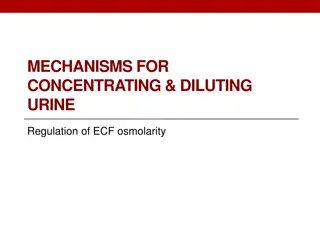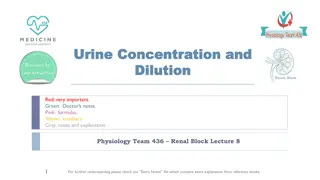
Understanding Diuresis Mechanisms through Experimental Groups Analysis
Explore the impact of water, saline, and Lasix intake on urine volume and composition in experimental groups A, B, C, and D. Learn about the mechanisms regulating water and sodium homeostasis in different conditions.
Download Presentation

Please find below an Image/Link to download the presentation.
The content on the website is provided AS IS for your information and personal use only. It may not be sold, licensed, or shared on other websites without obtaining consent from the author. If you encounter any issues during the download, it is possible that the publisher has removed the file from their server.
You are allowed to download the files provided on this website for personal or commercial use, subject to the condition that they are used lawfully. All files are the property of their respective owners.
The content on the website is provided AS IS for your information and personal use only. It may not be sold, licensed, or shared on other websites without obtaining consent from the author.
E N D
Presentation Transcript
Diuresis Diuresis Faciliatators Faciliatators Team Team
Objectives Objectives: : ? To measure the volumes and determine the compositions of urine excreted by 4 groups: Fasting drank 1L water drank 1L saline took 1 tab of Lasix 1. 2. 3. 4. ? To be able to discuss the mechanisms by which the body maintain the water and sodium homeostasis in these 4 different conditions.
Group A Emptied their bladders at 8:00 am and discarded the urine. From 8:00 they are restricted to take any fluids and they are asked to provide various urine samples for analysis at: 10:00 am, 12:00 noon, 2:00 pm and 3:00 pm.
Group B Emptied their bladder at 10:00 am and discarded the urine. At 12:00 noon emptied their bladder again, but this time they measured its volume and provided a sample for analysis. This sample will be pre-experimental sample. Drank 1 liter of water immediately after providing the pre- experimental sample. Were then asked to empty their bladders and provide post- experimental samples every half an hour after drinking water until 3:00 pm.
Group C Emptied their bladder at 7:00 am and discarded the urine. At 9:00 am emptied their bladder again, but this time they measured its volume and provided a sample for analysis. This sample will be pre-experimental sample. Drank 1 liter of 0.9% saline (isotonic saline) immediately after providing the pre-experimental sample. Were then asked to empty their bladders and provide post- experimental samples every hour after drinking saline until 3:00 pm.
What is 0.9% saline (isotonic saline)? ? contains 154 mmol of NaCI, equivalent to 9 g of salt or 3.6 g of sodium. ? The sodium concentration of isotonic saline is equivalent to the normal sodium concentration of plasma water.
Group D Emptied their bladder at 8:00 am and discarded the urine. At 10:00 am emptied their bladder again, but this time they measured its volume and provided a sample for analysis. This sample will be pre- experimental sample. Swallowed a Lasix (Furosemide) tablet 40 mg with the help of 25 ml of water immediately after providing the pre-experimental sample. Were then asked to empty their bladders and provide post- experimental samples every half hour after taking Lasix until 3:00 pm.
What is Lasix? Furosemide is a loop diuretic Its also called osmotic diuretic used in the treatment of hypertension, congestive heart failure and edema. It inhibits the sodium-potassium- 2 chloride co- transport system located within the ascending limb of the Loop of Henle.
Urine samples used to determine: ? Volume ( measuring cylinder) ? Sodium and potassium concentration ( flame photometry) ? PH ( PH meter) ? Osmolality ( Osmometer)
Flame photometry Osmometer
Measuring cylinder PH meter
Calculation ? Total sodium excretion is obtained by applying following equation: ? Sodium excretion rate is obtained by applying the following equation:
Group A ? What will happen? Subsequent urine sample is lesser in volume and darker yellow in color that shows the kidneys try to conserve water in fasting state.
Group A Deprive of H2O 1 ? Plasma Osmolarity 2 Stimulates Osmoreceptors in anterior hypothalamus 3 Thirst 3 ADH secretion from posterior pituitary H2O drinking 4 H2O permeability in late distal tubule and collecting duct 5a H2O reabsorption Plasma Osmolarity Toward Normal 5b Urine osmolarity and urine volume 6
m 1 Drink 1L H2O Group B Plasma Osmolarity 2 3 Inhibits osmoreceptors in anterior hypothalamus Thirst 3 ADH secretion from posterior pituitary H2O permeability in late distal tubule and collecting duct H2O drinking 4 5a H2O reabsorption and excretion Plasma osmolarity toward Normal 5b Urine Osmolarity and urine volume 6
Isotonic Saline (0.9%) 1 liter ? Group C ? Volume of E.C.F. Osmolality same (as isotonic saline) total solute amount Stretch on right atrium (volume receptors in right atrium) ANP (Atrial Natriuretic peptide) Na excretion by Kidneys
1 tab of Lasix (furosemide) (40mg) with 25ml of water ? Group D ? Action starts 1-2 hours and lasts for 4-6 hours (1/2 life of furosemide is 6hr) Acts on thick ascending limb of loop of Henle and blocks the Na- K-2Cl co-transport (called loop diuretic) Na excretion in urine and water excretion (osmotic drag)





















